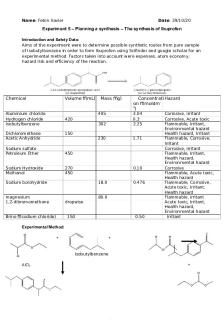Synthesis of Cyclohexene PDF

| Title | Synthesis of Cyclohexene |
|---|---|
| Course | Organic Chemistry I |
| Institution | Tarleton State University |
| Pages | 8 |
| File Size | 253 KB |
| File Type | |
| Total Downloads | 38 |
| Total Views | 142 |
Summary
Synthesis of Cyclohexene...
Description
Michaela Scott Geetha 2423-520 Apr. 16, 2017 Experiment 9: Synthesis of Cyclohexene Lab Report
Purpose:
To generate cyclohexene from the acid catalyzed dehydration of cyclohexanol through E1 mechanism. Materials Used: - Small distillation tube - 250 mL beaker - 50 mL round bottom flaks - 25 mL round bottom flask
-
Graduated cylinder Thermometer Erlenmeyer flask
Table of Chemicals: Chemical Name
Chemical Structure
Cyclohexanol
Molar Mass
Physical State
100.158 Colorles g/mol s Liquid
Meltin g Range 24C
Boilin g Point
Refractiv e Index
Quantit y Used
160C
1.465
3 mL
1.431
Phosphoric Acid
98 g/mol
Colorles s Liquid
20C
158C
Calcium Chloride
110.984 g/mol
White Solid
782C
1600C
Sulfuric Acid
98.078 g/mol
Colorles s Liquid
10 C
337C
Diagrams and Equations:
Theoretical YieldsCylcohexanol 3.0 mL * .9624 g/mol= 2.8872 g/ 100.158 g/mol= .0288 mol * 1/1= .0288 mol * 82.143 g/mol= =2.36879g Cyclohexene Sulfuric Acid .25 mL * 1.84 g/mol= .46 g/ 98.079 g/mol= .0047 mol * 1/1= .0047 mol * 82.143 g/mol= = .3861g Cyclohexene
Phosphoric Acid .25 mL * 1.88 g/mol= 7.52 g/ 98 g/mol= .0767 mol*.85= .0652 *1/1= .0652 mol*82.143 g/mol= = 5.3577 g Cyclohexene Limiting ReactantCyclohexanol Procedure: A 25 mL round bottom flask was obtained and 3 mL of cyclohexanol was measured and poured into the flask. 4 mL of 85% Phosphoric acid was added as well as 5 drops of Sulfuric Acid. A simple distillation apparatus was set up with a beaker full of ice at the receiving end. Boiling chips were added to the mixture and placed into the heating mantle with at stirring magnet. The mixture was distilled until it reached 90C. The distillate was then transferred to a large test tube to remove the acid layer on the bottom. The organic layer was dried by adding Calcium Chloride and then decanted into a pre-weighed flask to determine the percent recovery of the product. Potassium permanganate was added to a sample to determine the cyclohexene had formed. Data and Observations: Percent Recovery: 100* 1.499g/2.3769g= 63.07% The product turned from purple to brown when potassium permanganate was added, indicating that the double bond in cyclohexene had formed.
Discussion: In this experiment cyclohexanol is taken which has an OH attached and when an acid is added the hydrogen protons attach to the OH to form H2O. This water is then removed and forms a carbocation to which the hydrogens then form a double bond on either side of the carbocation. This process can be tested by applying the Zaitsev rule which predicts the most stable product will be the product that is the most substituted. Potassium permanganate is used to determine if the process was completed. When cyclohexene meets the Potassium permanganate it decolorizes the reagent to form Manganese dioxide which is brown and a diol. This experiment offered a low percent recovery rate but this can be improved by either distilling to dryness or by being more careful when decanting after drying. Conclusion: The formation of Cyclohexene was performed by adding two acids and then tested by using potassium permanganate
References “ChemSpider” ChemSpider. N.p., n.d. Web. 2017. Mohrig, Jerry R., David G. Alberg, Gretchen Holifmeister, Paul F. Schatz, and Christina Noring Hammond. Laboratory Techniques in Organic Chemistry. New York: W.H. Freeman, 2014. N. page. Print.
Michaela Scott Geetha 2423-520 Apr. 16, 2017 Experiment 9: Synthesis of Cyclohexene Post Lab Questions
1. 1-methylcyclohex-2-ene would be the product of a E1 dehydration of 2methylcyclohexanol. 2.
3. An alkane would be produced from a reaction with CH3Cl2 and bromine....
Similar Free PDFs

Synthesis of Cyclohexene
- 8 Pages

Lab report cyclohexene
- 6 Pages

SYNTHESIS OF DIMETHYL ETHER
- 54 Pages

Synthesis of Isopentyl Acetate
- 4 Pages

Synthesis of Sudan-1
- 4 Pages

The synthesis of Ibuprofen
- 4 Pages

Synthesis of methyl orange
- 9 Pages

Synthesis of Aspirin
- 10 Pages

Synthesis of Acetanilide
- 5 Pages

Synthesis of p-nitroacetanilide
- 6 Pages

Synthesis of Flavonol 2
- 13 Pages
Popular Institutions
- Tinajero National High School - Annex
- Politeknik Caltex Riau
- Yokohama City University
- SGT University
- University of Al-Qadisiyah
- Divine Word College of Vigan
- Techniek College Rotterdam
- Universidade de Santiago
- Universiti Teknologi MARA Cawangan Johor Kampus Pasir Gudang
- Poltekkes Kemenkes Yogyakarta
- Baguio City National High School
- Colegio san marcos
- preparatoria uno
- Centro de Bachillerato Tecnológico Industrial y de Servicios No. 107
- Dalian Maritime University
- Quang Trung Secondary School
- Colegio Tecnológico en Informática
- Corporación Regional de Educación Superior
- Grupo CEDVA
- Dar Al Uloom University
- Centro de Estudios Preuniversitarios de la Universidad Nacional de Ingeniería
- 上智大学
- Aakash International School, Nuna Majara
- San Felipe Neri Catholic School
- Kang Chiao International School - New Taipei City
- Misamis Occidental National High School
- Institución Educativa Escuela Normal Juan Ladrilleros
- Kolehiyo ng Pantukan
- Batanes State College
- Instituto Continental
- Sekolah Menengah Kejuruan Kesehatan Kaltara (Tarakan)
- Colegio de La Inmaculada Concepcion - Cebu




